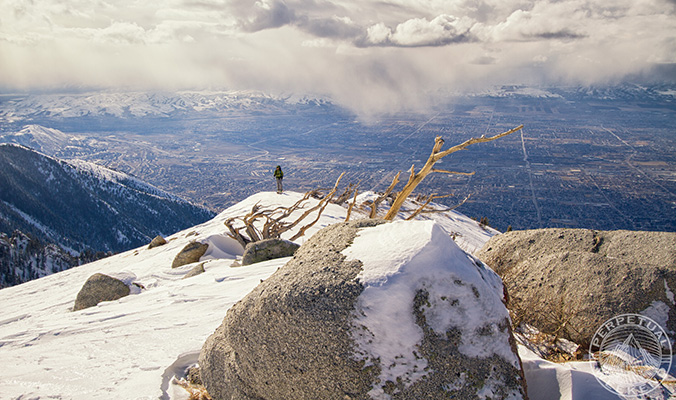When we published an article in the November 2013 issue on Wasatch Backcountry Alliance (WBA), the organization that provides a voice to backcountry users in and around Salt Lake City, Utah was just in its inception.
The WBA, a volunteer nonprofit, has experienced tremendous growth since then. Today it aims to reach members beyond SLC and the surrounding area—groups and individuals throughout the country who value the protection of the Wasatch’s backcountry terrain.
As of December 2014, the WBA has 1,300 additional members, up 1,000 from last year. It’s been working to prevent the One Wasatch campaign, which aims to link all seven of the major ski resorts in the SLC area, and partnered with Mountain Accord, a group of stakeholders planning the future fate of the Wasatch Mountains. We talked with Tom Diegel, WBA’s assistant to the vice president, to find out more.
Backcountry: How did the WBA get started?
Tom Diegel: The director of the Winter Wildlands Alliance, Mark Menlove, encouraged us to start our group. He’s now on our board. He and I are meeting with the mayor of SLC in one hour. [The Mayor’s] a great guy and a backcountry skier and is very much in support of us and what we’re doing.
BCM: Tell me about WBA’s mission at present?
TD: Fundamentally, we want to be a bit broader than stopping One Wasatch. Most of our members ski at the resorts. We are all about resort success and want them to succeed. We just want them to do it in their own existing footprint.
BCM: What are some of the most significant changes to take place with the Alliance in the last year?
TD: Ski Utah announced One Wasatch, essentially taking out some of the highest value backcountry skiing in the Wasatch. That loomed large for us. We were psyched that the press came to us right away to get our thoughts. Which surprised us, as we were new. Then we were invited to join the Mountain Accord.
BCM: What’s the current status of linking all seven mountains resorts? What does it mean for the Alliance and backcountry skiing in the area?
TD: It depends on who you talk to. It’s put out as a proposal. It’s increasingly talked about as a foregone conclusion. They say they can do the configuration on private land. But it affects public land. With ski resorts having open boundaries, it means high–value backcountry terrain could be accessed by ski lifts. If the one–mountain project came out, it would cause more backcountry crowding, and backcountry access would be pushed to more and more difficult to access and dangerous terrain.
We’ve had Interconnect for 30 years. Today, for a few hundred bucks, you can already ski all seven resorts in a day by hiking. At one point I was at Grizzly Gulch, above Alta, and saw three kids— five, seven and nine—with their parents backcountry skiing. It’s already super accessible on foot for people who are young or old, or not very avalanche savvy.
BCM: What is WBA’s current involvement with Mountain Accord?TD: We are one of the stakeholders and a voting member.
We were invited to join the Mountain Accord in SLC and Park City to get central stakeholders together to get an actionable vision for the future, including meeting with mayors for local cities, legislators, recreation guides, transportation people, ski resorts and Ski Utah. We have reps on all subcommittees of Mountain Accord, including environmental, recreation, transportation and economic. We’ve been an integral part of the process that reminds people that backcountry skiing has as much sway in this community as anything else does.
We did a big presentation to all the Mountain Accord subcommittees on “what is backcountry skiing and why is it important” because we realized that many city managers, engineers, and mayors needed clarification on the differences between backcountry skiing, cross–country skiing and resort skiing—and why people are so passionate about backcountry skiing.
BCM: How are you recruiting members for the Alliance? How do you see the Alliance growing over the next one to three to five years?
TD: We’re getting members all the time. Powderwhore Productions’ Noah Howell and Andrew McLean are on our board; a lot of people see Andrew’s blog.
Last weekend I had a friend visit from Vermont to ski some backcountry lines. I told him if you don’t support this cause it won’t be here in a few years. We can have members from around the country who have skied here, will ski here and want to ski here, and that’s important.
To learn more and join WBA, visit wasatchbackcountryalliance.org.












My worry is the explanation by Vail and Talisker is all of this development is taking place on” private land” which makes no inherent interest when it affects public lands which this Canyons/Park City resort connection will do. When private development makes any impact, marginal or significant impact, the concerns and interest of the public out weigh the interest of the private landowner. Why hasn’t this discussion been brought to the forefront? I believe Park City and Summit County will blindly accept Vail/Talisker’s view without any, and I mean any input from the Federal Government and the State of Utah which stupidly believes it is good thing. There has been no environmental impact statement or analysis other than a lot of we don’t won’t it or we feel it is a good thing. I want to see some real discussion and action. For one thing, the 9990 lift should never have been built where it is and really be move 100 yards back down from its oresent location,